Cultural influences shape fashion by blending traditional textiles, patterns, and symbolism with modern designs, allowing you to see stories, values, and identities in what people wear. From African bold prints to Asian draping techniques and indigenous craftsmanship, each style reflects history and community pride. Global festivals and cities like Paris and Tokyo mix these elements, creating a vibrant, interconnected fashion scene. Keep exploring to discover how heritage continues to inspire the evolving world of style.
Key Takeaways
- Traditional textiles and patterns embed cultural stories, symbols, and social values, enriching contemporary fashion with authenticity and identity.
- Indigenous techniques and craftsmanship preserve cultural heritage while influencing modern designs through embroidery, dyeing, and weaving.
- Cultural festivals and global fashion capitals showcase traditional attire, fostering cross-cultural exchange and innovative style blending.
- Incorporating traditional motifs and textiles into modern silhouettes respects cultural origins and promotes collaborative, ethical fashion practices.
- Globalization accelerates cultural diffusion, integrating diverse styles into mainstream fashion and creating a vibrant, interconnected global fashion landscape.
The Role of Traditional Textiles in Modern Fashion
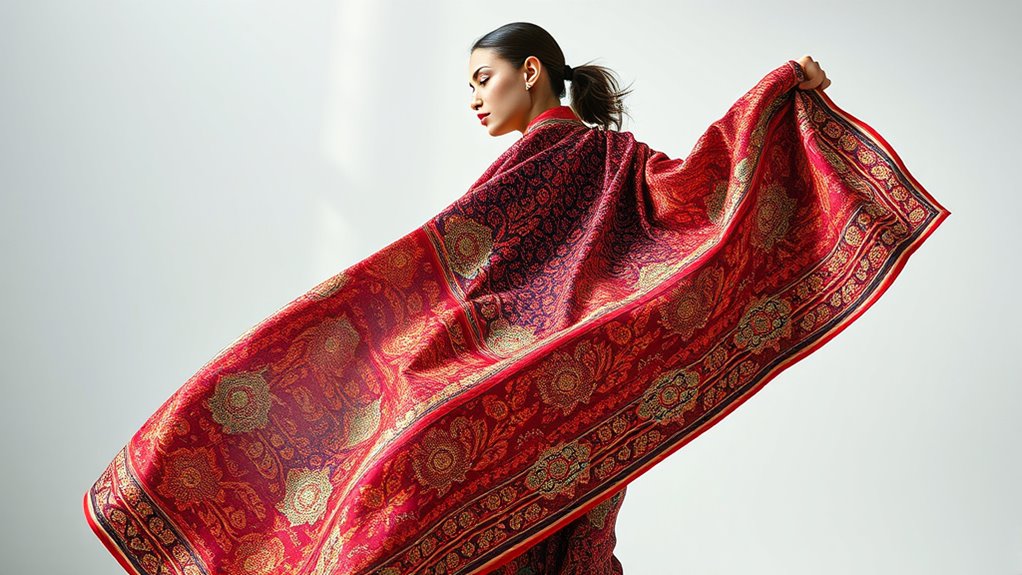
Traditional textiles have become a vital influence in modern fashion, blending cultural heritage with contemporary design. You’ll notice designers incorporating fabrics like ikat, batik, and handwoven textiles into runway collections and everyday wear. These textiles add richness, texture, and authenticity to modern pieces, making them stand out. You might see a traditional pattern transformed into a bold print on a jacket or a fabric’s intricate weaving used as a statement panel. This fusion preserves age-old techniques while making fashion more meaningful and unique. As you explore current trends, you’ll realize that these textiles connect you to different cultures, telling stories through their craftsmanship. They serve as a reminder that fashion can celebrate history while staying fresh and innovative. Incorporating natural materials and vintage-inspired elements further enhances the connection between traditional techniques and modern aesthetics. Additionally, understanding survivalism can inspire designers to use sustainable, durable fabrics rooted in traditional methods, emphasizing resilience and eco-friendliness. Exploring cultural preservation can also motivate the integration of traditional textiles into contemporary designs, ensuring these techniques are passed down and celebrated. Moreover, the resurgence of eco-conscious practices encourages designers to choose traditional textiles that are environmentally friendly and sustainable, strengthening the bond between fashion and ecological responsibility. Incorporating innovative dyeing techniques can further elevate these textiles, blending tradition with modern innovation.
African Patterns and Their Cultural Significance
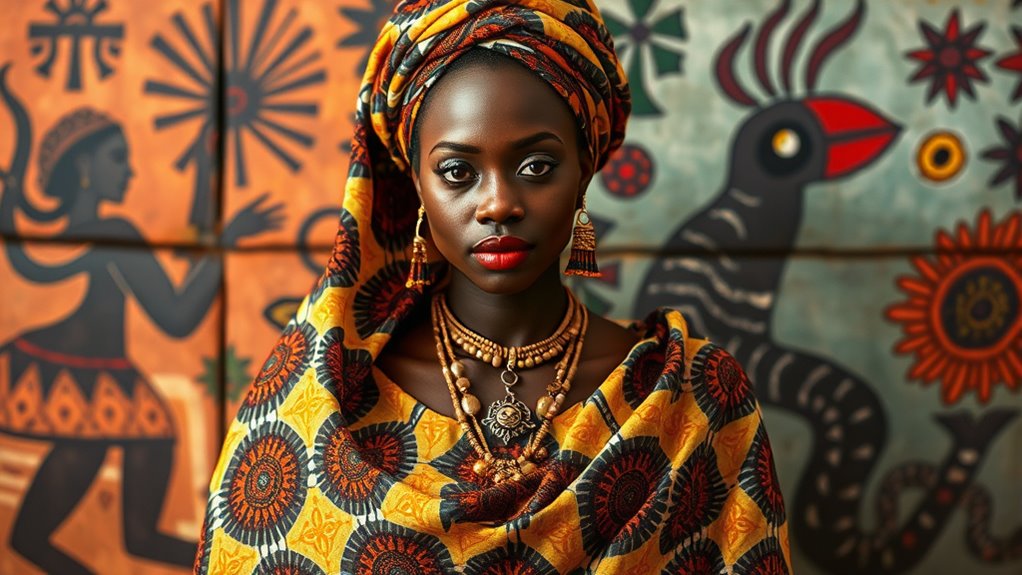
African patterns are rich with symbolism that reflects community, history, and beliefs, making them more than just decorative elements. You’ll notice how these designs serve as expressions of identity and cultural pride. The techniques and materials used also reveal the skill and traditions passed down through generations. Cultivating a growth mindset when studying these patterns allows for a deeper appreciation of their evolving meanings and significance. Recognizing the symbolic meanings behind each motif can deepen your understanding of the culture that created them. Additionally, understanding the compatibility of various cultural symbols can enhance your appreciation of their interconnectedness and shared histories. The cultural significance of these motifs often extends beyond aesthetics, embodying stories, proverbs, and social values that continue to influence contemporary fashion.
Symbolism and Identity
Many African patterns carry deep symbolic meanings that reflect a community’s history, beliefs, and social status. When you wear these designs, you’re not just making a fashion statement—you’re expressing your identity and cultural roots. Each pattern often tells a story or signifies a specific value, such as bravery, wisdom, or spiritual connection. For example, certain geometric shapes might represent unity, while specific colors can denote social rank or life stages. By choosing these patterns, you honor traditions and communicate your belonging to a particular group. This connection between clothing and identity helps preserve cultural heritage and fosters pride within communities. Wearing African patterns becomes a powerful way to celebrate your ancestry and share your story with others. Additionally, understanding the cultural significance behind these patterns enriches the appreciation of their artistic and historical importance. Recognizing the artistic techniques used in creating these textiles further enhances their value and meaning. Appreciating these cultural elements also encourages a deeper respect for the artisans and their craftsmanship.
Techniques and Materials
The techniques and materials used in creating African patterns are carefully chosen to reflect cultural values and artistic traditions. You’ll notice vibrant dyes, intricate beadwork, and handwoven textiles that tell stories of heritage and identity. These methods often involve natural resources like plant-based dyes and locally sourced fibers, emphasizing sustainability. The craftsmanship includes techniques such as embroidery, tie-dye, and appliqué, each with symbolic meanings. Additionally, the use of cultural significance in pattern design helps preserve and communicate community histories and beliefs. Incorporating traditional craftsmanship ensures the preservation of heritage skills across generations, strengthening cultural identity. Moreover, many artisans employ community-based approaches that encourage collaboration and knowledge sharing to keep traditional techniques alive. Furthermore, implementing payment processing methods can facilitate the distribution of these textiles to a global market, supporting local artisans and their communities. Recognizing the importance of relationships in these communities underscores the collaborative nature of traditional craftwork and its role in cultural continuity.
Asian Garments: Draping and Symbolism
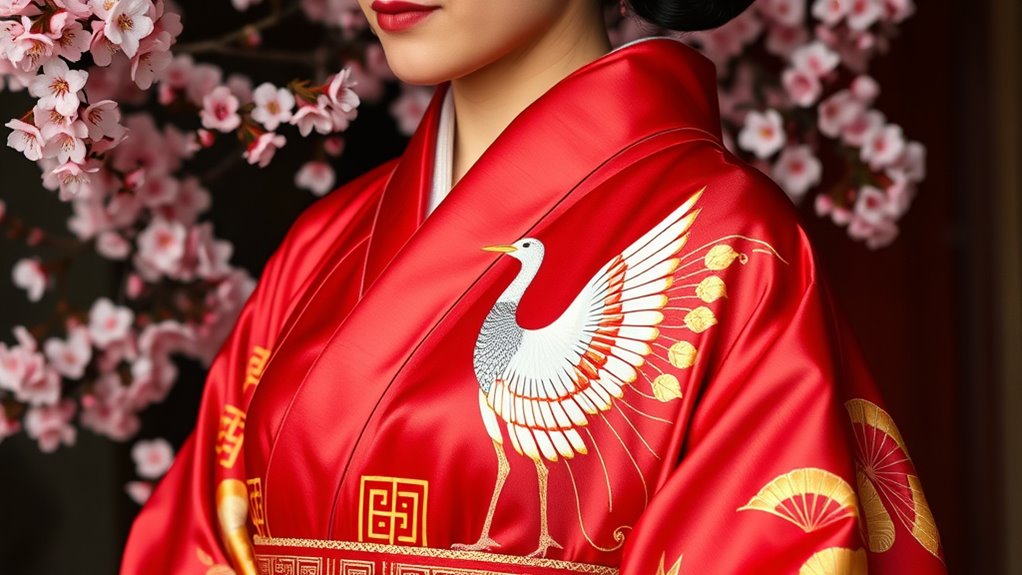
Asian garments often feature intricate draping techniques and rich symbolism that reflect cultural values and social status. When you wear a kimono, for example, you notice how the carefully wrapped fabric signifies tradition and respect. The way the fabric folds and ties isn’t random; it communicates meaning—such as elegance, age, or occasion. In India, the saree’s draping style can indicate regional identity or social standing. Symbols embroidered or woven into garments, like dragons or phoenixes, carry cultural stories or spiritual significance. These details aren’t just decorative; they serve as visual language, expressing identity and conveying respect for heritage. Additionally, the average ice cream consumption in the United States demonstrates how cultural preferences can influence regional gastronomic traditions, much like traditional clothing reflects cultural identity. The choice of textile materials used in garments often highlights local resources and craftsmanship, further emphasizing regional uniqueness. Recognizing the cultural symbolism behind these garments helps deepen appreciation for their historical and societal importance. Understanding how traditional attire varies across regions reveals the diversity within Asian cultures and their unique narratives. Moreover, the fashion industry plays a significant role in preserving and promoting these traditional styles in modern contexts. By understanding these symbolic elements, you gain deeper insight into the cultural importance behind Asian fashion and how clothing acts as a reflection of societal values.
Indigenous Influences in Contemporary Clothing
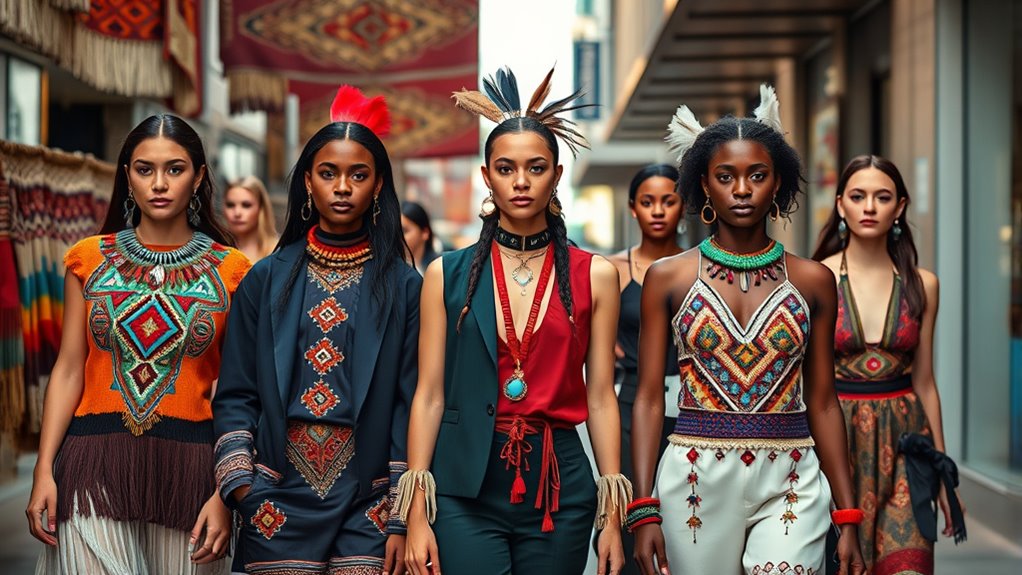
Have you noticed how indigenous designs continue to influence modern fashion? Today’s designers often draw inspiration from traditional patterns, textiles, and craftsmanship. These influences help preserve cultural identities and add unique flair to contemporary clothing. You’ll see indigenous motifs in accessories, prints, and embroidery, blending old and new styles seamlessly. This trend promotes appreciation for indigenous artistry and highlights their cultural significance. Incorporating traditional textiles into contemporary designs ensures the preservation of cultural heritage while appealing to modern aesthetics. Additionally, the use of authentic craftsmanship emphasizes the importance of supporting indigenous artisans and maintaining traditional techniques. Recognizing the cultural importance of these elements encourages respectful integration and celebrates diversity in fashion. Furthermore, embracing cultural narratives in fashion storytelling enriches the appreciation and understanding of the origins behind these patterns. Moreover, understanding the history behind these patterns enriches the narrative and respect for the cultures they originate from.
The Impact of Colonial History on Fashion Styles
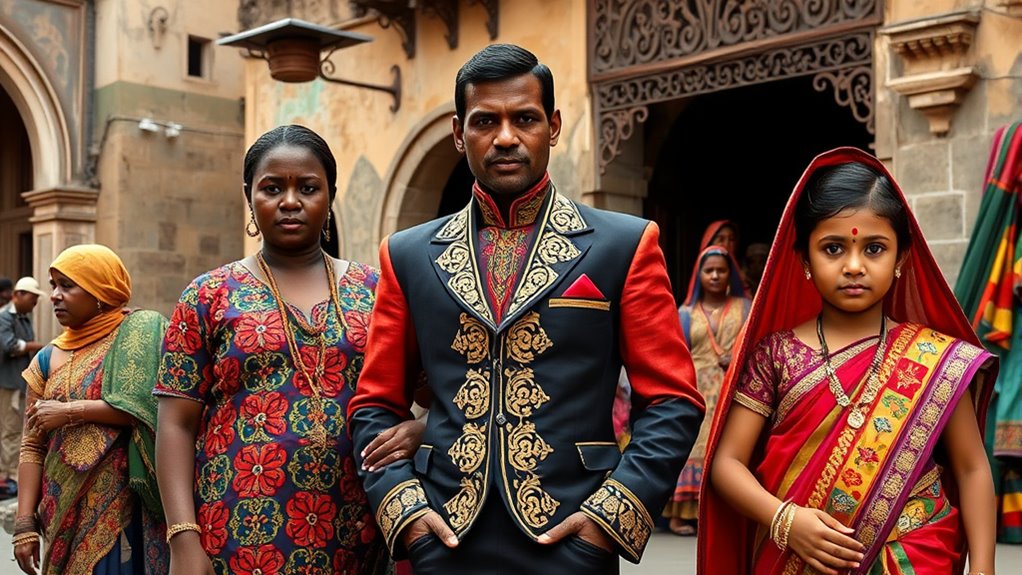
Colonial history has profoundly shaped fashion styles by introducing new materials, silhouettes, and motifs that persist today. When you look at traditional clothing from former colonies, you’ll notice European influences like tailored cuts, buttons, and lace blending with local textiles. Colonial powers often exported fabrics such as wool, silk, and cotton, which became staples in many regions. You may also see motifs and patterns inspired by colonial art and symbols embedded in modern fashion. These influences often symbolize a complex history, blending indigenous traditions with colonial styles. Additionally, the introduction of colonial-era textile techniques has left a lasting impact on local craft practices and fashion design. As a result, many contemporary garments carry traces of this colonial legacy, reflecting a layered identity. Understanding this history helps you appreciate how fashion becomes a canvas for cultural negotiation and resilience.
Cultural Festivals and Their Fashion Expressions
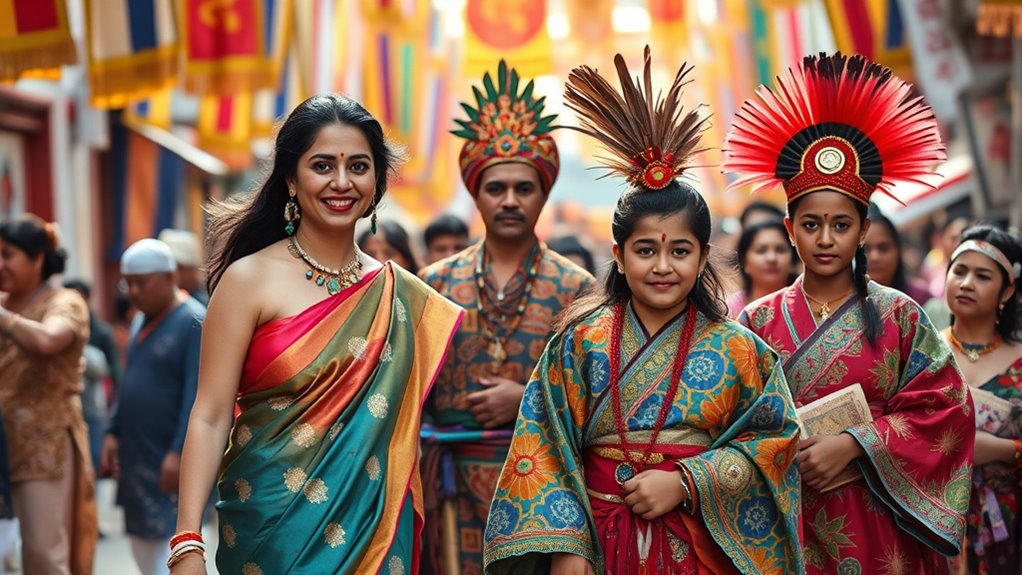
Cultural festivals serve as vibrant platforms where traditional attire comes alive, showcasing how history, identity, and community intertwine through fashion. During these celebrations, you see garments that tell stories—rich fabrics, intricate embroidery, and symbolic accessories. These outfits aren’t just clothing; they’re expressions of pride and heritage. You might notice:
Cultural festivals showcase vibrant traditional attire that tells stories of heritage, pride, and community through colorful fabrics and intricate details.
- Bright colors representing cultural symbolism
- Handwoven textiles passed down generations
- Unique jewelry with cultural significance
- Traditional headpieces and footwear
- Patterns that reflect historical narratives
The Evolution of Fashion Capitals Through Cultural Exchange

As global interactions increase, fashion capitals around the world have transformed into dynamic hubs where cultural exchange actively shapes styles and trends. You see this evolution in cities like Paris, Milan, New York, and Tokyo, where designers draw inspiration from diverse traditions and customs. These centers no longer rely solely on their local heritage; instead, they incorporate global influences to create innovative and eclectic styles. Fashion weeks showcase a blend of cultural motifs, fabrics, and techniques, reflecting a shared creative dialogue. This exchange fosters experimentation, pushing boundaries and redefining what’s considered stylish. As a result, fashion capitals become vibrant melting pots, constantly evolving through the cross-pollination of cultures, shaping a global aesthetic that’s rich, inclusive, and forward-looking.
How Globalization Shapes Cultural Fashion Trends
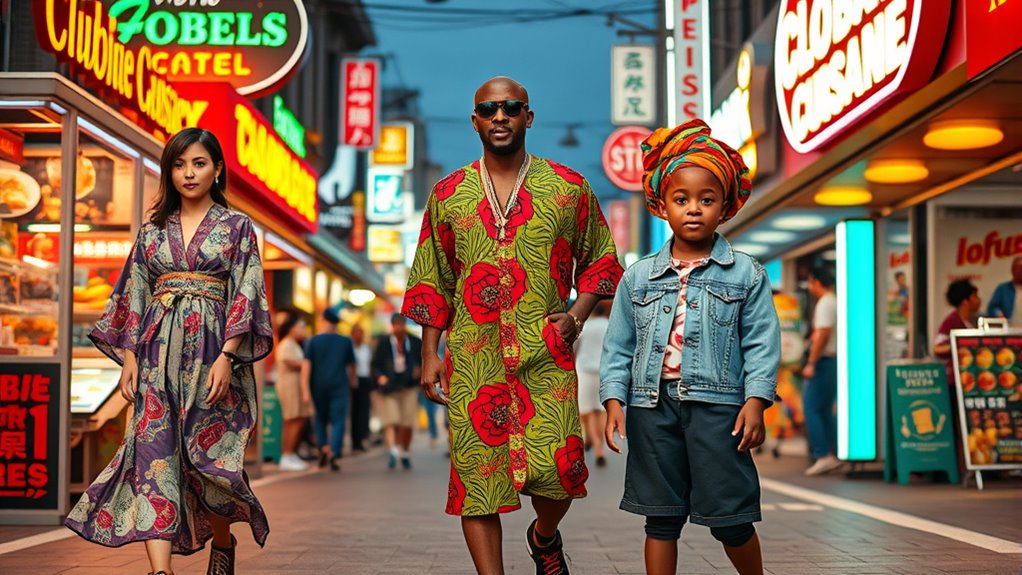
Globalization has accelerated the spread of fashion trends, turning local styles into worldwide phenomena almost overnight. You now see influences from distant cultures blending seamlessly into mainstream fashion. This interconnectedness means you can incorporate diverse elements into your wardrobe effortlessly. It also means fashion brands are constantly inspired by global styles, creating new trends faster than ever. To understand this better, consider how globalization:
- Facilitates instant access to international fashion collections
- Encourages collaborations across cultures and designers
- Promotes the rise of fast fashion adapting global trends quickly
- Inspires streetwear with global influences
- Fosters a shared fashion language across different regions
As a result, your style becomes a vibrant mix of global elements, reflecting a worldwide cultural mosaic. You’re not just wearing clothes; you’re participating in a dynamic, interconnected fashion conversation.
Preserving Heritage Through Fashion Design
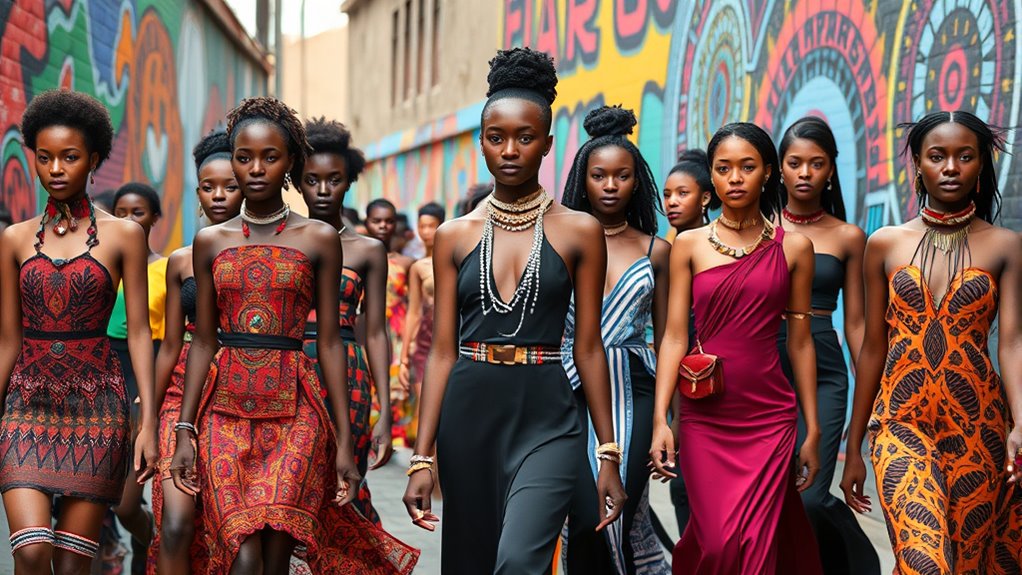
You can see how designers revive traditional craftsmanship to keep cultural skills alive. By integrating cultural symbols into modern pieces, they honor heritage while appealing to today’s fashion scene. Heritage-inspired collections serve as powerful reminders of a culture’s unique story and identity.
Traditional Craftsmanship Revival
Traditional craftsmanship is experiencing a meaningful revival as designers and consumers increasingly value heritage and authenticity. This movement highlights artisanship, passing down skills that connect fashion to cultural roots. You’ll see handcrafted fabrics, intricate embroidery, and time-honored techniques making a comeback in modern collections.
- Supporting local artisans and small workshops
- Using natural, traditional materials
- Incorporating age-old weaving and dyeing methods
- Emphasizing slow, sustainable production
- Celebrating unique, handcrafted details in designs
Cultural Symbols Integration
How do designers keep cultural heritage alive in today’s fashion? They incorporate authentic cultural symbols into their designs, ensuring these meaningful motifs aren’t lost or misused. You might see traditional patterns, colors, or icons subtly woven into fabrics or bold statements on garments. This approach honors the origins while making the symbols relevant to modern audiences. Designers often collaborate with artisans or communities, gaining respectful insight and ensuring accurate representation. By doing so, they create a bridge between past and present, giving cultural symbols a new life on global runways. This integration not only celebrates heritage but also sparks conversations about identity and history. When executed thoughtfully, it preserves cultural significance and elevates fashion into a form of storytelling.
Heritage-Inspired Collections
Designers crafting heritage-inspired collections intentionally draw from cultural symbols and stories to create fashion that honors the past. These collections serve as a bridge between tradition and modernity, keeping cultural narratives alive through design. You’ll notice these collections often feature authentic textiles, traditional motifs, and craftsmanship techniques passed down through generations. They celebrate unique cultural identities while making them relevant today.
To better understand, consider how you might:
- Incorporate traditional patterns into contemporary silhouettes
- Use indigenous fabrics to maintain authenticity
- Collaborate with local artisans for craftsmanship support
- Highlight cultural stories through embroidery or accessories
- Respect cultural significance to avoid appropriation
Frequently Asked Questions
How Do Local Artisans Influence Global Fashion Trends Today?
Local artisans shape global fashion trends by sharing their unique techniques and designs with the wider world. You see their influence in the incorporation of traditional patterns, textiles, and craftsmanship into mainstream styles. When designers collaborate with these artisans or draw inspiration from their work, it creates a blend of cultural authenticity and modern appeal. This connection helps preserve local traditions while making them relevant in the global fashion scene.
What Role Does Language Play in Traditional Fashion Symbolism?
Did you know that over 60% of traditional fashion symbols are conveyed through specific language or dialects? Language plays a vital role in traditional fashion symbolism by embedding cultural stories and values into clothing. When you wear these garments, you’re actively communicating heritage and identity. Words and phrases tied to patterns, colors, or accessories preserve history, allowing you to honor your roots while sharing meaningful stories through your style.
How Are Indigenous Techniques Adapted for Mass-Market Fashion?
You see how indigenous techniques are adapted for mass-market fashion by blending traditional methods with modern design. Designers often incorporate native patterns, textiles, and craftsmanship into mainstream collections, making them accessible to a broader audience. This process preserves cultural heritage while allowing consumers to appreciate unique artistry. However, it’s essential to respect the origins and guarantee proper acknowledgment to avoid cultural appropriation.
In What Ways Do Fashion Designers Preserve Cultural Authenticity?
You aim to preserve cultural authenticity by respecting traditions and sourcing materials ethically. While embracing modern trends, you honor original techniques and stories behind each design, ensuring they don’t get lost in mass production. You collaborate with artisans and communities, giving them recognition and financial support. This balance between innovation and tradition helps you create fashion that’s both globally appealing and deeply rooted in cultural heritage.
How Does Digital Media Impact Cultural Fashion Preservation Efforts?
Digital media plays a crucial role in cultural fashion preservation by making traditional styles more accessible worldwide. You can showcase authentic designs, share stories behind cultural garments, and connect with communities to promote understanding. It also helps preserve endangered techniques through tutorials and online archives. However, you should be mindful of respecting cultural origins and avoiding misappropriation, ensuring digital platforms serve as respectful tools for celebrating and safeguarding fashion heritage.
Conclusion
Think of the world’s fashion as a vibrant tapestry, each thread representing a culture’s unique story. By embracing traditional textiles, patterns, and festivals, you help weave a richer, more diverse global style. Remember, every stitch adds depth and meaning, forging connections across borders. So, keep exploring, honoring heritage, and letting your wardrobe be a canvas that celebrates our shared human journey through fashion’s beautiful mosaic.









